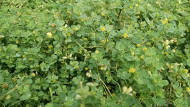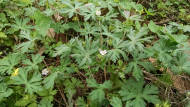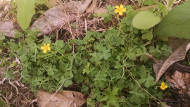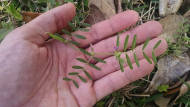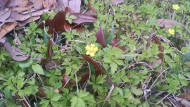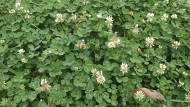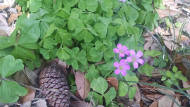A Better Sense of Place
2015 March 22 (Sun)
Spring weeds eternal
In my last post, I mentionned that the area I hoed and bordered between the sidewalk and the street is overtaken by exotic invasives. Yesterday, I was standing over it and wondering how to kill it back so that the seeds I sowed in October could sprout and see sunlight. But this morning, I was thinking that maybe it's a useful cover crop that I should live with until it dies from the heat. For this post, I've picked out seven plants, including the aforementionned exotic, that come back year after year to my yard in early spring. I think I've identified them all, and putting a name to a plant helps to understand where it's from and what it's doing. (Spoiler alert: only two are native.)
Low hop clover
This is the plant that's all up in my front bed. And the back alley. I was thinking it's black medick (Medicago lupulina), but after reading some more and comparing pictures, I think it's low hop clover (Trifolium campestre). It is an invasive exotic from Europe and western Asia. Its benefit as a cover crop is its nitrogen-fixing ability due to a symbiotic relationship with certain bacteria. This ability is common to three plants in this post.
Carolina geranium
I really expected to find this to be an exotic. It's not. Carolina geranium (Geranium carolinianum) is native to a very large part of the 48 contiguous states. This is great news because it's all over and going to flower right now.
Slender yellow wood sorrel
These grow in little clumps and always seem limp in full sun where they grow. I think this is slender yellow wood sorrel (Oxalis dillenii) and not plain old yellow wood sorrel (Oxalis stricta), and it is native. It's not a real clover, though, and it doesn't have nitrogen-fixing powers.
Common vetch
Yesterday, before learning what this stuff is, I weed-whacked a large area of it down to a neighbor-friendly height. It's just as well because this is common vetch (Vicia sativa), an exotic invasive from Eurasia somewhere. As you may be able to tell, it is a legume and does that whole nitrogen-fixing thing, the second of the three that do in this list.
Mock strawberry
A month or so ago, I learned that a difference between true strawberries, including the native Virginia strawberry (Fragaria virginiana), and mock or false strawberries is that true ones have a white flower while the fake ones have a yellow flower. Mine have yellow flowers and so are mock strawberries (Duchesnea indica). As the scientific name implies, they are exotic, from east and south Asia.
White clover
Everyone should easily recognize these: white clovers (Trifolium repens). They're real clovers and have nitrogen-fixing bacteria in their root nodes. Bees love them. Here's the bad news: they're exotic, from Europe, north Africa, and west Asia.
Pink wood sorrel
The final plant I picked out is this clover-looking thing. It's actually not a real clover and is closely related to the yellow wood sorrel above. It's pink wood sorrel, and I'm pretty sure it's Oxalis debilis and not Oxalis articulata. It's an exotic from South America.
